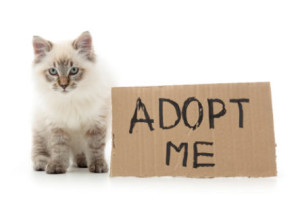Posts Tagged ‘vet’
How To Conquer Mealtime With A Picky Pet
 Do you have a picky pet? There is actually a difference between a picky and a finicky eater. A picky eater will occasionally refuse to eat and can easily be tempted with a slice of cheese added to his bowl. A finicky eater is a dog that has decided to give up dog food for good.
Do you have a picky pet? There is actually a difference between a picky and a finicky eater. A picky eater will occasionally refuse to eat and can easily be tempted with a slice of cheese added to his bowl. A finicky eater is a dog that has decided to give up dog food for good.
Have you ever wondered why your dog refuses to eat its food? If you give your pet treats or table scraps all day, it may just turn up its nose if you give plain dog food. If you are going to give your pet bacon or steak for breakfast, would you blame it for shying away from just the dog food? Chances are you might just be able to answer your own question by looking in the mirror. By caving in and giving those treats, you may have created a “monster” that becomes finicky or picky.
If there is no disease or illness present, then you just may have a finicky or picky eater. A picky dog will maintain its healthy weight, be alert and playful. It will also have a shiny coat, and is usually not a concern. When it suddenly stops eating, dropped a few pounds, and has a less lustrous hair coat, these symptoms may be a sign of illness or disease. In this situation, I would recommend a veterinary check-up as soon as possible.
So if you just have a finicky eater, here are some ways to persuade it to eat.
- Tone down the treats- A finicky eater is more likely to eat if it is not comparing its dog food to a liver treat.
- Feed often- Try feeding smaller amounts of its regular food three to four times a day. Set the food out for 30 minutes. If it isn’t eaten, pick it up and offer it again later. By doing this, you are helping your dog learn that no other option will exist. Don’t give in! Eventually, your dog will eat if it is hungry.
- Exercise- It is good for so many things and it increases a dog’s hunger. Try always exercising your pup before a meal.
- Spay or Neuter- If you haven’t already, fix your pup. Besides the many health and behavioral benefits, it can help prevent a finicky eater.
- Make it positive- Always make feeding a positive experience. By keeping feeding time positive, the overall experience will also provide positive reinforcement for your pet. Praise your dog when he eats his food and give him attention only after the meal is gone.
- Keep it quiet- Feed your dog in a quiet area without children or other dogs mulling around.
- Try different times- Some dogs eat better in the afternoon, others eat better an hour after you are home. Test it and see what time and situation work best for yours.
- Resist temptations- Try the other tips before giving into the urge to tempt your pup to eat with people food. You’ll find that a few pieces of cooked chicken will perhaps tempt him for a time but he’ll soon grow bored of that too.
Above all, be patient with your dog and watch it closely for signs of illness. Work with your veterinarian or a dog behaviorist if you are concerned about its health. Time, self-discipline, and consistency will do much to cure the finicky eater. Eventually, “my dog won’t eat” will become a thing of the past! If you are still struggling, contact our office so we can help!
Caring For A Deaf Dog
 It is human nature for everyone to boast that they have the perfect family, including their pets. But sometimes life throws us a curveball and we have to adjust to make it the best possible. Our pets sometimes have impairments like deafness that make it harder for them to adjust to everyday life. During the third week of September we recognize this impairment as Deaf Dog Awareness Week. Whether it is congenital or acquired it can lead to frustrations in training the pet, which isn’t the pet’s fault.
It is human nature for everyone to boast that they have the perfect family, including their pets. But sometimes life throws us a curveball and we have to adjust to make it the best possible. Our pets sometimes have impairments like deafness that make it harder for them to adjust to everyday life. During the third week of September we recognize this impairment as Deaf Dog Awareness Week. Whether it is congenital or acquired it can lead to frustrations in training the pet, which isn’t the pet’s fault.
Deafness can be caused by some hereditary issues which is known as congenital deafness. Hearing loss can also happen due to an ear infection, injury to the ear or it may be due to old age. Loud noises may also cause hearing loss, as can certain drugs.
Congenital deafness is most commonly related to the white coats of dogs. The white coats have unpigmented skin which produces white hair. If there is unpigmented skin in the inner ear, the nerve endings atrophy and die off in the first few weeks of the puppy’s life, resulting in deafness. This deafness can affect both ears or it can affect only one ear.
Early signs that your pet may be deaf is that it plays more aggressively or bites too hard because it is not deterred by the other puppy’s yelp of pain. It may not awaken during feeding time unless it feels vibrations or is bumped by a littermate. The owner may notice that it doesn’t respond to being called when sleeping, too far away or looking at you. There are several tests that you can do at home to assess that your pet is deaf, but the most reliable method is BAER testing. It is 100% reliable in determining if your pet is deaf. This test is a procedure using computers to record electrical activity of the brain in response to sound stimulation.
Outside of the obvious physical defect, deaf dogs are just everyday normal dogs. They play, sleep, and share their lives with us as companions, but they just don’t hear. A person that discovers this will be often faced with many negative warnings from misinformed people but with proper training, your impaired pet can lead a happy and active life. There are very few health considerations that apply to all deaf dogs.
Most people think that they are hard to train which could not be farther from the truth. They just need to be trained with the positive reinforcement approach to training. Since they can not hear, they rely on using visual signs instead of sound. This can be an advantage, since they are more focused and doesn’t have the noise distractions from other pets in the class. They may need more available time spent with them to build a solid foundation for training. So a person that has little time to train them may not be a good match. It is also good to have them interact frequently with other people and dogs.
Since a deaf pet cannot hear, it may be best to take steps to assure their safety. To prevent them from running off, it is important to exercise them on a leash frequently or have them in a fenced area. There are vibration collars available that can aid in getting the dog’s attention to call them back with hand signals.
Pets are always perfect in our eyes, even though some of them are impaired to some degree. If you have any concerns or questions please feel free to contact us.
FAQ’s About Pet Vaccinations
 Vaccinations are part of a basic pet wellness program that the Olsen Veterinary Clinic administers in Glen Carbon and the surrounding area. If you are not familiar with veterinary concerns or have never owned a pet up to this point, it is understandable that you might not know exactly what the pet vaccinations can do to safeguard your pet’s health. As August has been designated National Immunization Awareness Month, here are some frequently asked questions we get from pet owners regarding dog and cat vaccinations.
Vaccinations are part of a basic pet wellness program that the Olsen Veterinary Clinic administers in Glen Carbon and the surrounding area. If you are not familiar with veterinary concerns or have never owned a pet up to this point, it is understandable that you might not know exactly what the pet vaccinations can do to safeguard your pet’s health. As August has been designated National Immunization Awareness Month, here are some frequently asked questions we get from pet owners regarding dog and cat vaccinations.
What is a vaccination?
A vaccination is an injection that is given under the skin to stimulate the production of antibodies by the pet’s immune system against specific infections. They are needed once the antibodies transferred from the mothers to the newborn puppies and kittens wears off, which usually occurs within weeks of birth.
Are pet vaccinations harmful to my pet?
A vast majority of the vaccinations are actually quite safe and cause no illness to the pet. However, some pets may have mild side effects that can include fever, swelling, redness and digestive upset. If this has previously occurred it may be important to let your veterinarian know so that steps can be made to prevent or minimize the side effects.
What are “core vaccinations”?
Core vaccinations are vaccines that protect your pet against a handful of common and dangerous illnesses. Rabies is among the most important, because it is fatal to pets and can be spread easily to humans and other mammals. Because of this, it is important to vaccinate both cats and dogs against rabies. Other vaccinations that are considered core vaccines for your dog include canine hepatitis, parvovirus and canine distemper. While in cats, the core vaccinations include feline calicivirus, feline distemper, and Feline Herpes Virus along with the rabies vaccine.
What other vaccinations should I consider?
There are other diseases that can affect your pet. Here we tailor the vaccinations depending on the probable risks that your pet might incur. If your dog is quite mobile, groomed or boarded, or is in contact with other dogs, we would recommend vaccinating for Bordetella or as it is commonly known as “kennel cough.” Another disease that is becoming more prevalent seen in dogs is Canine Influenza. This disease is also contracted by contact with infected animals, so this may be one to consider. Finally if your pet is in contact with a lot of ticks or is in the woods, I would possibly recommend vaccinating to protect your pet from Lyme disease which is carried by the deer tick.
Why does my pet need booster shots?
Just as the original immunity provided from the mother’s milk fades over time, prescribed vaccines have a limited protective span. They can wear off over time and then your pet will be vulnerable to the diseases which can be deadly. The booster shots help keep the level of immunity consistent to ensure the best possible protection for life.
How often must the vaccinations be updated?
The vaccinations provide protections for different lengths of time. Some may be one year, for example rabies, while some can be longer. Since we tailor the vaccination schedule to meet your needs, we can provide you a schedule showing when each vaccine should be updated. If you happen to miss a scheduled update, it is best to bring your pet in as soon as possible so that the protection will not decrease.
The Olsen Veterinary Clinic urges pet owners to schedule the necessary pet vaccinations and updates with your veterinarian. By keeping your pet vaccinated properly, you will help to ensure that your pet has a long and healthy life.
Three Keys To Water Safety For Dogs
 Oh, the sounds of summer! Many people and their pets will spend numerous hours this summer basking on a beach, boating in a lake, or even lounging by a pool in their own backyard. Many pets love being around water, but each year approximately 40,000 pets lose their lives in drowning accidents. You need to look out for your pet around water, since even the strongest, most enthusiastic swimmers can get into trouble. The keys to water safety for dogs are prevention, preparedness and awareness.
Oh, the sounds of summer! Many people and their pets will spend numerous hours this summer basking on a beach, boating in a lake, or even lounging by a pool in their own backyard. Many pets love being around water, but each year approximately 40,000 pets lose their lives in drowning accidents. You need to look out for your pet around water, since even the strongest, most enthusiastic swimmers can get into trouble. The keys to water safety for dogs are prevention, preparedness and awareness.
Prevention
Believe it or not, not all breeds are Micheal Phelps-type swimmers. For example, the Bassett Hound and English Bulldog just are not built for swimming, so it is important to have a secure fence and gate around your pool and never leave your pet unsupervised.
Make sure that your pet can get out of the pool. If it jumps or falls in, it may panic and drown. Even the strongest swimmers can tire easily.
If you are taking your pet boating or in a river or ocean, it may be wise to invest in a dog floatation device and use it. Just like people, it’s easy for your pet to develop a cramp and become exhausted too far from shore or get overwhelmed by the tides.
Preparedness
Since pools are filled with chemicals that control the water and algae, and lakes and ponds can be a common source for parasites, it may be a good idea to bring fresh drinking water for your pet. The chemicals and parasites can cause your pet to become ill, which may lead to vomiting, diarrhea and other health issues.
One of the best things that you can do is to take courses in pet first aid and CPR. These are available at many local Red Cross chapters and sometimes taught by a local veterinarian. A near-death dog rescued from the water may be saved by your prompt actions—if you know what to do.
As I mentioned before, if your dog isn’t much of a swimmer or is older and debilitated, get him a personal floatation device. These are especially great for family boating trips, because most have study handles for rescue when a pet goes overboard. It is also important to keep a long leash on the boat at all times in case you need to restrain your pet for any reason.
It is also important to bring fresh water to rinse off your pet after swimming to get out the chlorine and other pool chemicals, as well as bacteria and dirt he might get on him from an ocean or lake. Don’t let your dog sit in a wet collar as hot spots can develop as well.
Awareness
Be aware of your dog’s condition as he plays. Remember that even swimming dogs can get hot, so bring fresh water and offer it at every opportunity. When your dog is tiring, call it a day. A tired dog is a good dog, but an exhausted dog is in danger of drowning.
Be particularly careful with young and old dogs. Young dogs can panic in the water and old dogs may not realize that they aren’t as strong as they used to be. Keep them close to shore, and keep swimming sessions short.
During the hot summer, many dogs are drawn to water to cool off and swimming also meet your dog’s exercise needs with a low-impact option of movement. But accidents can happen in a hurry. So try to prevent these accidents by being prepared and aware. If you have any further questions, please feel free to contact us.
Questions For New Pet Owners To Ask Their Vet
 Congratulations! Welcome to the world of pet ownership. This might have happened to you over the holiday season. As responsible pet owners, it is important to keep your pet healthy and a good way to do that is to develop a relationship with a veterinarian. As with a person choosing their own physician, it is important to find a veterinarian that meets their needs, as well as getting the right sense of education, experience and personality.
Congratulations! Welcome to the world of pet ownership. This might have happened to you over the holiday season. As responsible pet owners, it is important to keep your pet healthy and a good way to do that is to develop a relationship with a veterinarian. As with a person choosing their own physician, it is important to find a veterinarian that meets their needs, as well as getting the right sense of education, experience and personality.
Before you meet with a potential veterinarian, learn as much about the practice as you can by reading the clinic’s website, search the vet’s Facebook or Twitter page and see what their clients are saying. Maybe look for testimonials and note any red flags that may present. It may be helpful to schedule a meeting with the veterinarian-not for an exam, but to see what chemistry the veterinarian has with your pet. And then take the information gathered and decide if maybe they might be a good fit for you.
A pet owner must consider the health of their pet and tailor questions to address any needs or conditions that he or she has, especially if your pet may need specialized care in the future. The owner needs to consider the veterinary clinic’s policies and make sure that they meet the owner’s criteria. As in almost every situation, communication is important. It is important that you can get in touch with your veterinarian when you need to. Make sure the practice and your specific vet have open lines of communication, and know all the channels you can use to contact them.
With that in mind, here are some possible questions that you may want to ask a new veterinarian.
- How many veterinarians are in the practice? Will you see the same veterinarian every time or do the doctors switch or rotate without notice?
- How far in advance does the practice typically schedule appointments?
- If you need same-day care, will the practice see you or refer you to an emergency veterinarian?
- What are the qualifications of the technical staff? If your pet needs a simple procedure can you see a tech or do you need an appointment with the main vet?
- If your pet has a specific disease or ailment, does the veterinarian have experience treating that condition?
- Are the veterinarians open to alternative treatments like chiropractic care or acupuncture?
- Does the practice offer emergency or after-hours care? If not, where would the practice send you?
- In case referral work is needed, where does the veterinarian send them?
- What is the best way to contact the veterinarian during the business day and after hours?
- Is the veterinarian willing to answer questions via email?
There are many good veterinarians in practice out there, so finding an appropriate one may take some time and extra research. But in the long run, the task may be less challenging and lead to fewer problems by taking time to find one that meets your criteria.
October is National Pet Adoption Month
 October is National Pet Adoption Month and many people constantly are adopting pets from rescue organizations. Peoples lives are enriched in ways that they have never dreamed possible. Bringing home a new pet is such an exciting and fulfilling experience, but it can be a bit daunting as well, especially if you have never shared your home with a furry companion. Here are some tips to get your relationship off on the right foot.
October is National Pet Adoption Month and many people constantly are adopting pets from rescue organizations. Peoples lives are enriched in ways that they have never dreamed possible. Bringing home a new pet is such an exciting and fulfilling experience, but it can be a bit daunting as well, especially if you have never shared your home with a furry companion. Here are some tips to get your relationship off on the right foot.
Be prepared Before you bring your pet home, determine where your pet will be spending most of its time. Because it will be under a lot of stress with the change of environment, it may forget any housebreaking it has learned. An area with tiled, pergo, or linoleum floors may be best because it is easiest to clean up. You will also need to dog-proof the area where your pet will spend most of its time. This may mean taping loose electrical cords to baseboards, storing chemicals on high shelves, removing plants, rugs and breakables. The more prepared that you are, the smoother your new family member’s transition will be.
Shop for the basics You will need a leash, collar, food and water dishes and of course food. It is best to know what your new adoptee is eating as an abrupt diet change can cause diarrhea and other problems. If you change its diet, do it as a gradual change like maybe over 10 to 14 days. One other thing to buy is a medal id tag. It does not replace microchipping, but it does help some. If you are planning on crate training your pet, it is best to wait and take your pet with you to purchase it. This way you will get the proper size.
Consistency Make sure all family members are on the same page. Ground rules need to be set and the family members need to agree to follow and enforce them. For instance, if you don’t want your new pup on the couch, all the training in the world won’t help if your child lets it sit there with you when you are not home. Also, caring for your pet is a family effort and endeavor, so it is important that everyone understands their particular roles and responsibilities.
Adjustment Over the first few days to few weeks, your new pet will be undergoing an adjustment period. These surrounding are new to him, so you may notice some anxiety issues that may include appetite loss or suppressed bowel habits. It may even hide under or behind furniture or stay in one room. Don’t be alarmed-this is absolutely normal behavior. Give the pet time to acclimate to your home and family. By showing patience, you will help it through a tough, scary time and it will show the pet how wonderful his new home really is.
Set Schedule It is best to set a schedule for feeding, toileting and play/exercise. From Day One, your dog will need family time and brief periods of solitary confinement. Don’t give in and comfort it when it whines when left alone. Instead, give it attention for good behavior, such as chewing on a toy or resting quietly. By sticking with a schedule that you created, your pet will be bonded with you in no time and the pet will be showing its true personality.
Veterinary Care Schedule a first visit to your pet’s veterinarian during the first week. Bring any and all medical and vaccination records that were supplied by the shelter or rescue from which you adopted your dog. This first visit os a great time to get clues about your pet’s personality and past history, so don’t be afraid to ask lots of questions. Also, if your pet is not microchipped, this is a good time to do it because true love is hard to replace.
Congratulations! If you follow these tips, you’ll be on your way to having a well-adjusted family member. Make sure to contact us if you have any questions!
